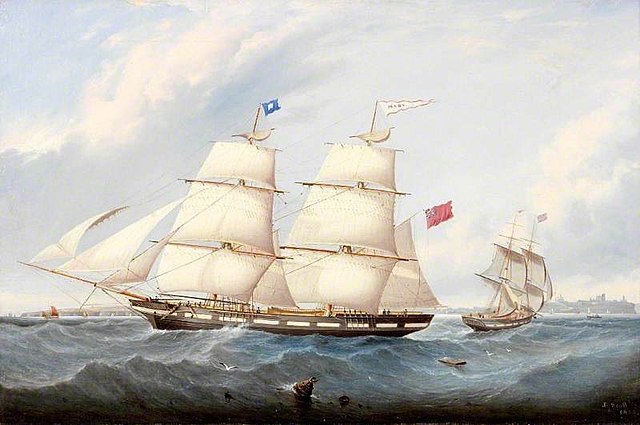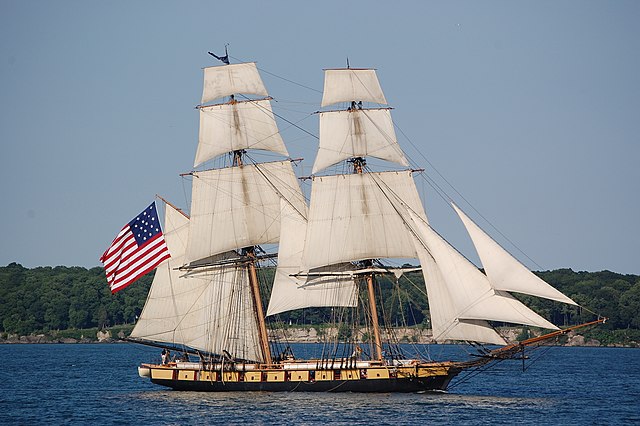Loading AI tools
Sailing vessel with two square-rigged masts From Wikipedia, the free encyclopedia
A brig is a type of sailing vessel defined by its rig: two masts which are both square-rigged. Brigs originated in the second half of the 18th century and were a common type of smaller merchant vessel or warship from then until the latter part of the 19th century. In commercial use, they were gradually replaced by fore-and-aft rigged vessels such as schooners, as owners sought to reduce crew costs by having rigs that could be handled by fewer men. In Royal Navy use, brigs were retained for training use when the battle fleets consisted almost entirely of iron-hulled steamships.


Brigs were prominent in the coastal coal trade of British waters. 4,395 voyages to London with coal were recorded in 1795. With an average of eight or nine trips per year for one vessel, that is a fleet of over 500 colliers trading to London alone. Other ports and coastal communities were also served by colliers trading to Britain's coal ports. In the first half of the 19th century, the vast majority were rigged as brigs, and that rig was retained for longer in the northeast of England.[1]: 49


In sailing, a full-rigged brig is a vessel with two square rigged masts (fore and main).[2] The main mast of a brig is the aft one. To improve maneuverability, the mainmast carries a (gaff rigged) fore-and-aft sail.[3]
Brig sails are named after the masts to which they are attached: the mainsail; above that the main topsail; above that the main topgallant sail; and occasionally a very small sail, called the royal, is above that. Behind the main sail there is a small fore-and-aft sail called the spanker or boom mainsail (it is somewhat similar to the main sail of a schooner). On the foremast is a similar sail, called the trysail. Attached to the respective yards of square-rigged ships are smaller spars, which can be extended, thus lengthening the yard, thus receiving an additional sailing wing on each side. These are called studding sails, and are used with fair and light wind only. The wings are named after the sails to which they are fastened, i.e. the main studding sails, main top studding sails, and the main top gallant studding sails, etc.[4]
A brig's foremast is smaller than the main mast. The fore mast holds a fore sail, fore top sail, fore top gallant sail, and fore royal. Between the fore mast and the bowsprit are the fore staysail, jib, and flying jib. All the yards are manipulated by a complicated arrangement of cordage named the "running rigging". This is opposed to the standing rigging which is fixed, and keeps mast and other objects rigid.[4]
A brig is "generally built on a larger scale than a schooner, and may approach the magnitude of a full-sized, three-masted ship."[4] Brigs vary in length between 75 and 165 ft (23 and 50 m) with tonnages up to 480.[5] A notable exception being the famous designer Colin Mudie's 'Little Brigs'[6] (TS Bob Allen and TS Caroline Allen), which are only 30 ft (9 m) long and weigh only 8 tonnes.[7] Historically, most brigs were made of wood, although some later brigs were built with hulls and masts of steel or iron.[3] A brig made of pine in the 19th century was designed to last for about twenty years (many lasted longer).[3][better source needed]
The word brig has been used in the past as an abbreviation of brigantine (which is the name for a two-masted vessel with foremast fully square rigged and her mainmast rigged with both a fore-and-aft mainsail, square topsails and possibly topgallant sails). The brig actually developed as a variant of the brigantine. Re-rigging a brigantine with two square-rigged masts instead of one gave it greater sailing power. The square-rigged brig's advantage over the fore-and-aft rigged brigantine was "that the sails, being smaller and more numerous, are more easily managed, and require fewer men or 'hands' to work them."[4] The variant was so popular that the term brig came to exclusively signify a ship with this type of rigging.[8] By the 17th century the British Royal Navy defined "brig" as having two square rigged masts.[9]

Brigs were used as small warships carrying about 10 to 18 guns.[5] Due to their speed and maneuverability they were popular among pirates (though they were rare among American and Caribbean pirates).[4][8] While their use stretches back before the 17th century, one of the most famous periods for the brig was during the 19th century when they were involved in famous naval battles such as the Battle of Lake Erie. In the early 19th century the brig was a standard cargo ship. It was seen as "fast and well sailing", but required a large crew to handle its rigging.[10]

Brigs were seen as more manoeuvrable than schooners. James Cook requested the conversion of the schooner HMS Grenfell to a brig, with the justification of the better control that he would have with a brig versus a schooner. The ability to stop the ship quickly (by backing sails) was particularly important for a vessel doing survey work.[11]: 82 The windward ability of brigs (which depends as much on hull shape as the rig) could be comparable to or better than contemporary schooners. The author and naval officer Frederick Marryat characterised brigs as having superior windward performance to the schooners of that time. Marryat is considered, by maritime historians, to be an authoritative source on such matters.[12]
A brig's square-rig also had the advantage over a fore-and-aft–rigged vessel when travelling offshore, in the trade winds, where vessels sailed down wind for extended distances and where "the danger of a sudden jibe was the large schooner-captain's nightmare".[13] This trait later led to the evolution of the barquentine. The need for large crews in relation to their relatively small size led to the decline of the production of brigs. They were replaced in commercial traffic by gaffsail schooners (which needed fewer personnel) and steam boats.


The famous mystery ship Mary Celeste, while sometimes called a brig, was clearly a brigantine.

Seamless Wikipedia browsing. On steroids.
Every time you click a link to Wikipedia, Wiktionary or Wikiquote in your browser's search results, it will show the modern Wikiwand interface.
Wikiwand extension is a five stars, simple, with minimum permission required to keep your browsing private, safe and transparent.